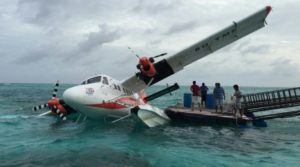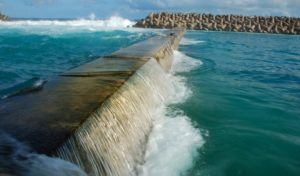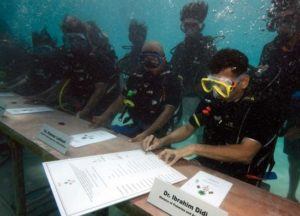That Sinking Feeling – How the Ministry of Tourism in The Maldives Addresses Climate Change

With rising temperatures and sea levels, The Maldives finds itself sinking – both economically and literally.
Rising sea levels caused by climate change pose varying risks to multiple companies, non-profits and organizations. But how should an organization address the challenges of climate change when they not only threaten business operations, but the very livelihood and even existence of an entire nation?
The Maldives is currently facing such a situation. The archipelago nation consisting of nearly 1200 islands is surrounded by rising seas and temperatures that threaten the source of nearly 70% of the country’s GDP – Tourism [1]. As the waters continue to creep towards shore, risking to swallow the nation completely, the nation’s Ministry of Tourism looks to three primary threats to its economic livelihood:
1) Everything Is Not Beachy

With vast coastlines surrounded by the blue of the Indian Ocean, The Maldives is renowned for its beautiful beaches. Nearly 75% of tourism is driven by Beach Holidays [2], and almost all tourist accommodations are within 100 m of the coastline [7]. This draw for tourists is at risk though from rising sea levels and beach erosion. Over 97% of the inhabited islands reported beach erosion [2], and nearly half of the tourist resorts also reported erosion damage caused by increasingly higher water levels [5].
2) Nothing is Better, Down Where It’s Deader, Under the Sea

Below the water’s surface, The Maldives also attracts tourists with its rich biodiversity. With the seventh largest coral reef system globally [5], tourists flock to The Maldives for excellent snorkeling and diving. However, climate change is endangering this fragile natural resource. The living coral reefs are highly susceptible to the rising water temperatures, and the impact of climate change has been a phenomena called Coral Bleaching that destroys the once rich underwater environment [3]. Since coral reefs are the foundation of the aquatic ecosystem, all of The Maldives’ biodiversity is threatened as the reefs slowly fall apart.

3) Now Servicing Non-Stop Flights to Atlantis

In addition to the natural resources at risk from climate change, the man-made infrastructure supporting the tourism industry also faces challenges from rising sea levels. With approximately 90% of resort infrastructure within 100 m of a coastline only 1.5 m above sea level [7][5], any increases in sea level threaten to significantly impair the nation overall. Furthermore, the tourism industry’s most utilized point of entry, Male’ International Airport, is particularly at risk with over 30% of its infrastructure within 50 m of the coast and only 1.1 m above sea level [2][7]. As the water continues to rise, the primary source of nearly all tourism could be completely cut off with any damages to Male’ International Airport’s infrastructure.
The Tourism Adaptation Project
To ensure tourism and economic operations can continue in spite of climate changes, The Maldives Ministry of Tourism launched the Tourism Adaptation Project. This joint venture between public and private sectors seeks to mitigate the impacts of rising sea levels and temperatures through a myriad of operational enhancements and alterations.
Certain mitigation techniques are very short-term focused. One solution to the concerns around coastline erosion are to utilize beach nourishment techniques [11]. Popular among beachfront resorts, sediment and sand would be moved from different areas of the archipelago and pumped into eroded beaches, repairing eroded areas for a quick, albeit temporary fix. [4]
A more lasting solution involves the usage of organic solutions. On the erosion side, one such strategy is to plant vegetation such as mangroves around the coastline [7]. Studies have shown that the plants not only weaken waves caused by rising sea levels and weather, thereby decreasing erosion, but are also useful in improving biodiversity as well [8]. Utilizing organic solutions is also effective in addressing the risks to coral reefs. By planting either actual or artificial coral reefs, the aquatic ecosystem can be stabilized thus driving sustainability to biodiversity, and subsequently the snorkeling and diving industries. [6][10]
Finally, additional infrastructure can leave long-lasting safeguards to climate change. A common measure is to build seawalls to prevent damage to coastline and existing infrastructure [6]. Furthermore, Male’ International Airport is undergoing additional runway development and coastal protections to help minimize the risks generated from rising sea levels. [9]

Is It Enough?
While the Ministry’s Adaptation Project provides many defenses from the impacts of climate change, they are mostly short-term responses rather than actual lasting solutions. Safeguards can be introduced and emissions cut within the country, but the global problem of climate change will still threaten the nation. In order to ensure sustainability of tourism and The Maldives itself, the country has pushed for multilateral policy changes urging other nations to adopt climate change mitigation agreements such as the Paris Climate Agreement [12]. Only by looking for a global solution to this shared problem can the natural beauty of The Maldives be preserved for generations of tourists to come.
[796 words]
References:
[1] Bureau of Economic and Business Affairs, “2014 Investment Climate Statement – Maldives,” http://www.state.gov/e/eb/rls/othr/ics/2014/227151.htm, accessed November 2016.
[2] Ministry of Housing, Transport and Environment, “National Adaptation to Climate Change,” http://www.ifrc.org/docs/IDRL/National%20Adaptation%20Programme%20(Climate%20change))/MALDIVES%20Adaptation%20to%20Climate%20Change.pdf, accessed November 2016.
[3] Hoegh-Guldberg, Ove. “Climate change, coral bleaching and the future of the world’s coral reefs.” Marine and freshwater research 50, no. 8 (1999): 839-866. Accessed November 2016.
[4] Shakeela, Aishath, and Susanne Becken. “Understanding tourism leaders’ perceptions of risks from climate change: an assessment of policy-making processes in the Maldives using the social amplification of risk framework (SARF).” Journal of Sustainable Tourism 23, no. 1 (2015): 65-84. Accessed November 2016.
[5] Ministry of Environment, Energy and Water, “National Adaption Program of Action,” http://unfccc.int/resource/docs/napa/mdv01.pdf, accessed November 2016.
[6] Heather Hosterman, Joel Smith, “Economic Cost and Benefits of Climate Change Impacts and Adaptation to the Maldives Tourism Industry,” 2015, Ministry of Tourism, http://www.tourism.gov.mv/downloads/publicaltions/Economic.pdf, accessed November 2016.
[7] Sovacool, Benjamin K. “Perceptions of climate change risks and resilient island planning in the Maldives.” Mitigation and Adaptation Strategies for Global Change 17, no. 7 (2012): 731-752. Accessed November 2016.
[8] Duarte, Carlos M., Iñigo J. Losada, Iris E. Hendriks, Inés Mazarrasa, and Núria Marbà. “The role of coastal plant communities for climate change mitigation and adaptation.” Nature Climate Change 3, no. 11 (2013): 961-968. Accessed November 2016.
[9] Ministry of Environment and Energy, “Maldives’ Intended Nationally Determined Contribution,” http://www4.unfccc.int/ndcregistry/PublishedDocuments/Maldives%20First/Maldives%20INDC.pdf, accessed November 2016.
[10] Clark, S., and A. J. Edwards. “An evaluation of artificial reef structures as tools for marine habitat rehabilitation in the Maldives.” Aquatic Conservation: Marine and Freshwater Ecosystems 9, no. 1 (1999): 5-21. Accessed November 2016.
[11] Sovacool, Benjamin K. “Hard and soft paths for climate change adaptation.” Climate Policy 11, no. 4 (2011): 1177-1183. Accessed November 2016.
[12] Chris Mooney, Joby Warrick, “How tiny islands drove huge ambition at the Paris climate talks,” The Washington Post, December 12, 2015, https://www.washingtonpost.com/news/energy-environment/wp/2015/12/11/how-tiny-islands-drove-huge-ambition-at-the-paris-climate-talks/, accessed November 2016.
Image References:
https://www.sciencenewsforstudents.org/article/current-coral-bleaching-event-longest-known
http://www.arkipal.org/tag/energy/
https://maldivesfinest.com/seaplane-accident




This post highlights the challenges facing what will likely be one of the first nation-state victims of climate change–the Maldives. You point out several interesting (albeit temporary) mitigation efforts that the Maldives is currently pursuing. I’m wondering if they have looked at what others affected by rising tides, like the Netherlands, are doing? It seems the Maldives faces a stark choice at this point (barring some kind of massive shift in the trend towards warmer temperatures and higher tides): engineer their way to safety or leave the Maldives, or much of the Maldives behind. Is the Maldives considering installing lock systems, water diverting walls or other similar Dutch-inspired major engineering projects? If not, does the Maldives have a plan to relocate its population–either to higher ground or to another island? Both options pose significant operational challenges and fundamentally reshape what the Maldives is and will be in the future. What are businesses in the Maldives doing? Are they leading the way towards a solution or are they preparing to jump to safety?
Interesting you should pose that question TK, relocating the entire populace is exactly what their former president advocated at one point: http://www.nytimes.com/2009/05/10/magazine/10MALDIVES-t.html
I agree that more needs to be done because all the current solutions are strictly temporary but cannot see how such a small nation can structurally tackle this climate issue without cooperation of the large countries. Sea levels will continue to rise and overcome walls and re-erode beaches. Moreover, as temperature goes up, the negative effects happen faster so the returns on the temporary solutions might diminish over time.
Very interesting post! One of the images in your post rings a bell. I remember reading about how the government of the Maldives decided to hold a cabinet meeting underwater to raise awareness and bring much needed attention to the gravity of the problem! I agree with you that the measures which have been taken are only short-term. Building seawalls can probably be scaled to protect the nation’s inhabitants when sea levels rise to dangerous levels. However, this would destroy the natural beauty of the islands and could even be detrimental to the biodiversity.
I would be interested to hear your thoughts on long term measures you think should be taken. Considering the Maldives is a relatively small nation, it probably doesn’t have the ‘political clout’ to bring mass attention to the problem. Perhaps, the Maldives government can work with governments of neighboring countries in South Asia to support its cause at global climate change forums?
I’ve never been to the Maldives but it’s on my bucket list! I hope it’s not too late to experience the picturesque offerings of this archipelago.
Very interesting, Andrew. I think this article resonated a lot with me because we have the same issue with the Great Barrier Reef in Australia! In fact, Australia has exactly that – a long term plan that has a roadmap until 2050! Check it out here – http://www.environment.gov.au/marine/gbr/long-term-sustainability-plan
I agree with both you and the other commenters that there are long term measures that need to be taken, but given how reliant they are on tourism, it’s probably easier said than done. A couple of things that I thought that may help in curbing the demand of tourism is 1) restricting demand through pricing (although the Maldives is already an expensive location) and 2) replacing some of the access with virtual reality!
This truly exemplifies the negative externality problem that climate change brings, and the exacerbation of the problem when the third party sufferers of climate change are smaller countries with less political leverage and less capital. The Maldives face consequences for which there are no ideal solutions – temporary solutions are common because local businesses are only able to/willing to sink that much capital into retaining beaches for their own livelihood. When it comes to the large scale solutions that are necessary, the capital investment needed from the government will significantly increase national debt. Building a Dyke system (such as in the Netherlands) is a huge project to embark upon from scratch, and also requires huge infrastructural shifts. Hotels and other beach-side facilities will have to move in-land, and beaches will fall on the outside of the protected zone. Alternatives may come in drastic changes in urban planning – zoning laws to make all lower floors of buildings dispensable, shifting residential and commercial use into upper floors, and transitioning the city into a Venice-like destination. Should natural mangroves suffice to weather the worst of the storm, they may be the most cost effective and aesthetically appealing option. I really hope that we will see significant investment in the Maldives, hopefully with external investment and support, to develop a strong response for long-lasting resilience against the rising sea levels.
Tourism and environment is a topic that is often coupled in many areas of the region including Maldives. It is especially sensitive issue when the economy of region is highly dependent on the tourism industry. In this situation, it is extremely difficult to devise and implement solutions to mitigate the issue as it has direct impact on the welfare of the people. Although the short term measures do supplement the conservation efforts, there needs to be a policy in place where there are other sources of economic growth other than tourism to fundamentally resolve the issue.
Wow, this seems like a really tough problem. Unfortunately, the temporary solutions seem to be just that – temporary. If rises in sea level continue as projected, this will put the Maldives in an extremely challenging their position. I think it would be wise for the Maldives, hopefully with the help of some of its friends, to start taking a look at a really conservative strategy for compensating with worst-case rises in sea level so that they’re at least prepared and have an actionable, well thought out plan they can execute if necessary to minimize the adverse effects that would hit their tourism-based economy.
The ocean engineering part of this problem is very interesting. Beyond seawalls, I would like to learn more about the government’s long-term R&D projects. It would also be helpful to see the data on projected sea level changes to look at this problem against time. While tourism and the economic survival of the population is important in the present, the larger concern is that the Maldives is likely to disappear during this century.
As someone who has always wanted to visit Maldives, I found your post fascinating. However, I must admit – my view of Maldives was limited to beautiful pictures I had seen online and similar accounts from friends and family who had visited the islands. Naturally, I found some of the points that you brought up gripping. What are your thoughts on municipal wastes that are smothering corals in neighboring reefs? Did you consider the effects of inadequate municipal incineration that causes severe air pollution during the monsoon season? I’m wary that attempts to solve one environmental problem have merely resulted in the proliferation of others. Clearly, the Maldives faces a variety of economic and development problems that are compounded by a restricted natural resource base and rapid population growth.